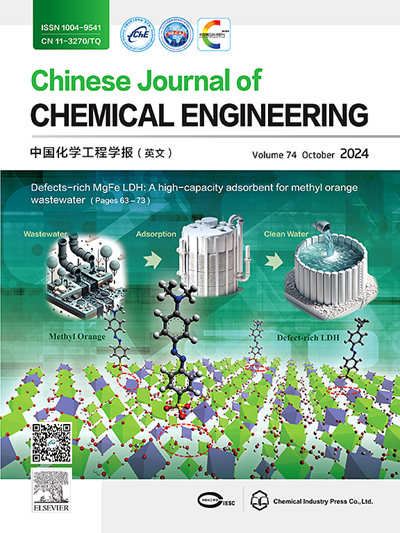Preparation of MoO3/γ-Al2O3 sulfur-resistant methanation catalyst with segmented plasma fluidized bed
IF 3.7
3区 工程技术
Q2 ENGINEERING, CHEMICAL
引用次数: 0
Abstract
In order to solve the shortcomings of MoO3/γ-Al2O3 catalyst for sulfur-resistant methanation, a segmented plasma fluidized bed reactor was designed, where plasma discharge zone and the fluidization zone were separated under higher discharge power. At the bed height of 30 mm, the gas velocity of 0.10 m·s−1 can provide a better fluidization state. The suitable discharge results can be achieved when the input power is 27 W and the discharge interval is 2.0 mm. With the extension of catalyst plasma treatment time, the conversion of CO decreases, but the selectivity of CH4 increases. Combined with N2 physical adsorption-desorption, XRD, TEM, Raman, TGA and TPR characterization, it was found that the active components of the catalyst are uniformly dispersed on the γ-Al2O3 support. After plasma treatment, tetrahedral Mo species was used as the active center, and the interaction between Mo and the carrier was strengthened. It provides a novel approach for preparing catalyst with dielectric barrier discharge (DBD) fluidized bed reactor.

分段等离子流化床制备MoO3/γ-Al2O3耐硫甲烷化催化剂
为解决MoO3/γ-Al2O3耐硫甲烷化催化剂的不足,设计了一种分段等离子体流化床反应器,在较高的放电功率下将等离子体放电区与流化区分离。在床层高度为30 mm时,0.10 m·s−1的气速可以提供较好的流化状态。当输入功率为27 W,放电间隔为2.0 mm时,可以获得合适的放电效果。随着催化剂等离子体处理时间的延长,CO的转化率降低,而CH4的选择性提高。结合N2物理吸附-脱附、XRD、TEM、Raman、TGA和TPR表征,发现催化剂的活性组分均匀分散在γ-Al2O3载体上。等离子体处理后,以四面体Mo为活性中心,增强了Mo与载体的相互作用。为介质阻挡放电(DBD)流化床反应器制备催化剂提供了一条新的途径。
本文章由计算机程序翻译,如有差异,请以英文原文为准。
求助全文
约1分钟内获得全文
求助全文
来源期刊

Chinese Journal of Chemical Engineering
工程技术-工程:化工
CiteScore
6.60
自引率
5.30%
发文量
4309
审稿时长
31 days
期刊介绍:
The Chinese Journal of Chemical Engineering (Monthly, started in 1982) is the official journal of the Chemical Industry and Engineering Society of China and published by the Chemical Industry Press Co. Ltd. The aim of the journal is to develop the international exchange of scientific and technical information in the field of chemical engineering. It publishes original research papers that cover the major advancements and achievements in chemical engineering in China as well as some articles from overseas contributors.
The topics of journal include chemical engineering, chemical technology, biochemical engineering, energy and environmental engineering and other relevant fields. Papers are published on the basis of their relevance to theoretical research, practical application or potential uses in the industry as Research Papers, Communications, Reviews and Perspectives. Prominent domestic and overseas chemical experts and scholars have been invited to form an International Advisory Board and the Editorial Committee. It enjoys recognition among Chinese academia and industry as a reliable source of information of what is going on in chemical engineering research, both domestic and abroad.
 求助内容:
求助内容: 应助结果提醒方式:
应助结果提醒方式:


